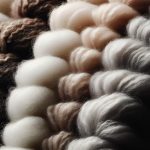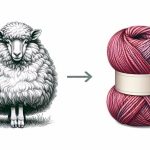Wondering if rayon is warm enough for winter? You're not alone. When it comes to choosing the right fabric for the colder months, mastering the art of layering is key.
In this exploration of fabric choices, we'll delve into the warmth and versatility of rayon, comparing it to winter stalwarts like wool, and uncovering the potential of rayon blends for cozy winter wear.
You'll also gain insights into layering techniques to make the most of rayon in cold weather, and discover other equally snug fabric options.
Get ready to elevate your winter wardrobe with a deeper understanding of rayon and other fabric choices that'll keep you warm and stylish all season long.
Key Takeaways
- Rayon has excellent insulating properties and can trap air to create a layer of warmth.
- Rayon blends, especially with wool or polyester, can enhance warmth and comfort.
- Layering rayon with moisture-wicking base layers and insulating pieces like wool or fleece can help stay warm in cold weather.
- Other cozy fabric options for winter include cashmere, wool, fleece, silk, and flannel.
Understanding Rayon: A Winter Fabric Overview
If you're wondering whether rayon is a good choice for winter clothing, it's important to understand how this fabric performs in cold weather. Rayon, a semi-synthetic fabric made from natural cellulose fiber, has several properties that make it a viable option for winter clothing. Despite being lightweight and breathable, rayon has excellent insulating properties, making it a suitable choice for the colder months. Its ability to trap air and create a layer of warmth around the body makes it an attractive option for winter wear.
When considering winter clothing choices, it's essential to look for fabrics that offer both comfort and warmth. Rayon's moisture-wicking properties help to keep the body dry and comfortable by drawing sweat away from the skin, making it an ideal choice for layering in winter. Additionally, rayon blends well with other fibers, allowing for the creation of fabrics that combine the best properties of each material. This means that rayon can be blended with wool or polyester to enhance its warmth and durability, providing a wider range of options for winter clothing.
Understanding rayon's properties and its potential for use in winter clothing can help you make informed decisions when selecting garments for the colder seasons.
Comparing Rayon to Wool: Which Is Warmer
When comparing rayon to wool for warmth in winter clothing, it is important to consider their insulating properties and comfort benefits. Both fabrics offer warmth, but they have distinct differences in their insulation factor and overall performance.
Here's a breakdown to help you understand which fabric is warmer for your winter wardrobe:
- Insulation Factor: Wool is known for its exceptional insulation properties. It traps heat close to the body and provides excellent warmth even in damp conditions. On the other hand, rayon has a moderate insulation factor. It offers some warmth but is not as effective as wool in extremely cold temperatures.
- Breathability: Wool is naturally breathable. It allows moisture to escape while still retaining heat, making it a great choice for various winter activities. Rayon, while breathable, may not wick away moisture as effectively as wool. This could potentially lead to discomfort in prolonged outdoor activities.
- Softness and Comfort: Rayon is prized for its silky, smooth texture. It provides a luxurious feel against the skin. Wool, although warm, may be coarser and less comfortable for those with sensitive skin.
- Versatility and Care: Wool is durable and retains its shape well. It requires less frequent washing, making it a practical choice for long-term wear. Rayon, on the other hand, is more delicate. It is prone to wrinkling and may require more careful handling and maintenance.
Understanding these distinctions between rayon and wool will help you make an informed decision when choosing the warmer fabric for your winter clothing.
Exploring Rayon Blends for Winter Wear
Exploring rayon blends for winter wear enhances your options for creating versatile and comfortable clothing. Rayon blends are excellent choices for insulation during winter. Blending rayon with other fibers such as wool or polyester can significantly improve its warmth-retaining properties, making it a great option for winter clothing.
Rayon blends provide a good balance between warmth and breathability, ensuring that you stay cozy without feeling overheated.
When comparing rayon blends to cotton for warmth, rayon generally outperforms cotton in winter wear. Rayon has better insulating properties than cotton, making it a more suitable choice for colder temperatures. Additionally, rayon blends are often softer and more comfortable against the skin compared to pure cotton fabrics. This makes rayon blends a preferred option for creating winter clothing that isn't only warm but also comfortable to wear throughout the day.
Incorporating rayon blends into your winter wardrobe expands your fabric choices, allowing you to create stylish and functional clothing that keeps you warm and comfortable during the colder months.
Tips for Layering Rayon in Cold Weather
Wondering how to effectively layer rayon for cold weather? Layering rayon for cold weather can be a game-changer for staying warm and stylish. Here are some expert tips to help you master the art of layering with rayon:
- Start with a Base Layer: Choose a lightweight, moisture-wicking rayon top or camisole as your base layer. This will help regulate your body temperature and keep you dry.
- Add Insulating Layers: Layer a cozy, insulating piece such as a wool or fleece sweater over your rayon base. This will trap heat and provide extra warmth.
- Consider a Rayon Blend: Opt for a rayon blend cardigan or jacket as an outer layer. The blend will offer warmth and the natural breathability of rayon.
- Accessorize with Scarves and Gloves: Complete your layered look with a stylish scarf and a pair of gloves. These accessories not only add flair to your outfit but also provide additional warmth.
Other Cozy Fabric Options for Winter
To layer effectively for cold weather, consider other cozy fabric options alongside rayon, such as cashmere, wool, and fleece.
Cashmere is a luxurious and ultra-soft fabric that provides exceptional warmth. It's lightweight, making it an excellent choice for layering without adding bulk.
On the other hand, wool is a classic winter fabric known for its excellent insulation properties. It can effectively regulate body temperature, keeping you warm without causing overheating.
When it comes to fleece vs. cashmere, fleece is a more affordable alternative that offers great warmth and insulation. It's also lightweight and dries quickly, making it ideal for outdoor activities in cold weather.
Silk and flannel are also popular choices for winter wear. Silk is a natural, breathable fabric that can be used as a base layer for insulation without adding bulk.
On the other hand, flannel is a soft and cozy fabric that provides excellent warmth and comfort. When considering silk vs. flannel, silk is more lightweight and ideal for layering, while flannel is thicker and provides a more substantial barrier against the cold.
Ultimately, these cozy fabric options offer a variety of choices to suit different preferences and activities during the winter season.
Frequently Asked Questions
Is Rayon Suitable for Extreme Cold Weather Conditions?
Rayon can be suitable for extreme cold weather conditions when used in layering options. It provides insulation and can contribute to thermoregulation. However, it may not be as warm as other natural fibers like wool.
Can Rayon Be Layered for Added Warmth in Winter?
Layering options with rayon can add warmth in winter. Its thermal properties make it a good choice for layering under other clothing. However, for extreme cold weather, consider layering with other insulating fabrics for added warmth.
How Does Rayon Compare to Other Synthetic Fabrics in Terms of Warmth?
When comparing insulation, rayon is less warm than other synthetic fabrics like polyester and nylon. However, its moisture-wicking properties make it a good choice for layering in winter to stay dry and comfortable.
Are There Any Specific Care Instructions for Maintaining the Warmth and Quality of Rayon in Winter?
To maintain the warmth and quality of rayon in winter, follow specific care instructions. Proper layering and warmth maintenance are key. Be sure to check the label for rayon maintenance guidelines to ensure it lasts through the season.
Can Rayon Be Used for Outdoor Winter Activities Like Skiing or Snowboarding?
For outdoor activities like skiing or snowboarding in winter, rayon can be used as a base layer for moisture-wicking and insulation. Layering options are crucial, so consider pairing rayon with other warm fabrics for optimal comfort.
- How Does Ring Spun Cotton Affect Garment Fit and Shape Retention? - August 13, 2024
- What Are the Challenges in Producing Ring Spun Cotton? - August 13, 2024
- Is Ring Spun Cotton Suitable for Plus-Size Clothing? - August 13, 2024




